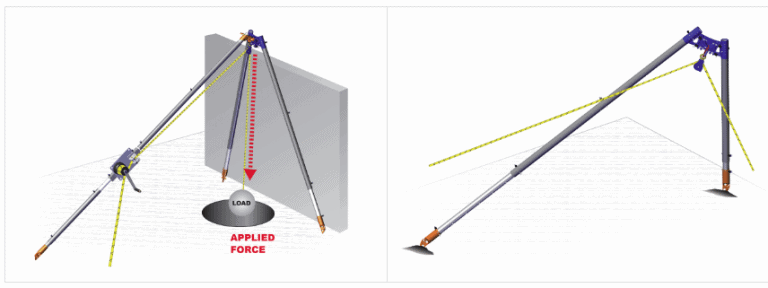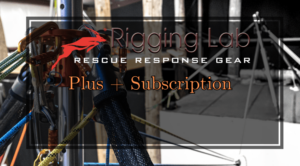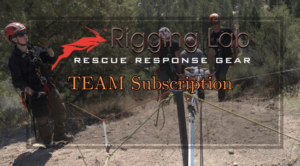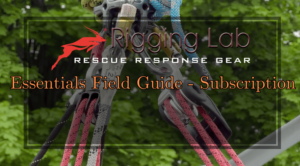Arizona Vortex Basic Configurations Overview
The Arizona Vortex stands out as one of the most versatile and essential tools in technical rescue and rigging. Its ability to adapt to various configurations makes it indispensable for professionals in rescue, rope access, and other vertical environments. In this overview, we’ll explore the basic configurations of the Arizona Vortex, highlighting its versatility and practical applications.
Basic Configurations of the Arizona Vortex
1. Monopod (Gin Pole)
- Application: Ideal for edge transitions or confined space rescues where minimal space is available.
- Key Features:
- Single-leg configuration.
- Supports vertical loads efficiently.
- Requires guying for stability.
2. Bipod
- Application: Commonly used for narrow edge transitions or situations requiring a stable directional anchor.
- Key Features:
- Two-leg configuration.
- Increased stability compared to the monopod.
- Often guyed to counteract lateral forces.
3. Tripod
- Application: The most versatile configuration, suitable for complex scenarios such as confined space entry and highline setups.
- Key Features:
- Three-leg configuration.
- Provides maximum stability.
- Self-standing and ideal for uneven surfaces.
4. Sideways A-Frame
- Application: Used for horizontal highlines or to manage loads in offset scenarios.
- Key Features:
- Lateral orientation for horizontal tension.
- Optimized for spanning gaps or supporting horizontal loads.
5. Easel A-Frame
- Application: Combines the benefits of vertical and horizontal load management.
- Key Features:
- Adjustable leg angles for varied applications.
- Ideal for steep edge transitions.

The Equal-Leg Tripod shown is a Directional Frame, as the frame supports a pulley system and the haul line is
not terminated onto the frame. The use of independent hobbles alone is normally considered acceptable to secure the feet in this configuration.
In this case, the hobbles form a triangle between the feet. Ideally the load should be suspended in the center of the triangle. As the load is moved away from the center of the triangle the Tripod will have a tendency to topple.
Care must be taken to ensure that the load is kept in the center of the triangle. Additionally, keep the haul line
close to the load line to prevent the tendency of movement on the head of the frame.
 |
 |

EASEL-LEG TRIPOD
(with Leg-Mounted Winch)
The Easel-Leg Tripod shown is an Anchor Frame as the rope that supports the load is anchored to the frame via a leg-mounted winch. The use of hobbles alone is normally considered acceptable to secure the feet in this configuration. However, the action of cranking the winch may cause unwanted movement of the Easel-Leg.
As with the Equal-Leg Tripod, the hobbles form a triangle between the feet. Ideally the load should be suspended in the center of the triangle. As the load is moved toward the outside of the triangle, the Tripod will tend to topple.
Care must be taken to ensure the load is kept well within the triangle.
 |
 |

EASEL-LEG TRIPOD
(with Leg-Mounted Winch)
The Easel-Leg Tripod shown is an Anchor Frame as the rope that supports the load is anchored to the frame via a leg-mounted winch. The use of hobbles alone is not adequate to secure this configuration.
The tendency of movement of this frame is forward (over the edge), therefore the addition of a back guyline (or
other appropriate measures) is required to secure the frame.

[thrive_lead_lock id=’49819′]Hidden Content[/thrive_lead_lock]

The A-Frame configuration shown is a Directional Frame as the rope supporting the load is directed through a pulley on the head and is not anchored to the frame. The example shown would require a combination of hobbles and Raptor Feet inserted into crevices and guys to provide security and stability.
An A-Frame configuration requires guylines connected to anchors both to the front (near or over the edge) and to the back of the frame. Additional guylines may be needed to prevent the A-Frame from moving sideways if the load were to shift laterally.

SIDEWAYS A-FRAME
The Sideways A-Frame Bipod shown is a Directional Frame as the rope supporting the load is directed through a pulley on the head and is not anchored to the frame. The example shown would require a combination of hobbles, Raptor Feet inserted into a crevice, and guys to provide security and stability.
A Sideways A-Frame configuration requires guylines connected to anchors out to each side of the frame. For
this reason, this configuration is well suited to environments where anchors are not available at the edge.


The Gin Pole configuration shown is a Directional Frame as the rope supporting the load is directed through a pulley on the head and is not anchored to the frame. The example shown would require a combination of hobbles, Raptor feet inserted into a crevice, and guys to provide security and stability. A Gin Pole configuration requires a minimum of three (3) guys, ideally separated by 120°. This may prove to be difficult to achieve in some environments as suitable anchors may not be available. Additional guys may be necessary for these situations.

Related Resources from Rigging Lab Academy
- A Guide to Artificial High Directionals
- Arizona Vortex Setup Essentials
- Understanding Highlines and Offset Systems
Peace on your Days
Lance












12 thoughts on “Arizona Vortex Basic Configurations Overview”
195486 861938Spot on with this write-up, I actually assume this website needs a lot a lot more consideration. Ill probably be once much more to read far more, thanks for that info. 713234
This is great article! Thank you 🙂
Hello! I simply would like to offer you a big thumbs up for your excellent
info you have right here on this post. I am returning to your site for more soon.
526672 850453Ill appropriate away grasp your rss feed as I cant in obtaining your e-mail subscription hyperlink or e-newsletter service. Do youve any? Please let me comprehend so that I could subscribe. Thanks. 891064
868152 455231This really is a good common sense article. Extremely useful to one who is just finding the resouces about this part. It will surely assist educate me. 768716
You have observed very interesting points! ps decent web site.
545360 803467What a lovely weblog. I will certainly be back once more. Please maintain writing! 771463
527842 199721When I originally commented I clicked the -Notify me when new surveys are added- checkbox and from now on whenever a comment is added I purchase four emails sticking with the same comment. Perhaps there is by any means you might get rid of me from that service? Thanks! 117809
983932 517754I like this blog so a lot, saved to my bookmarks . 323941
I like this website very much, Its a very nice position to read and incur info .
136185 825753What a lovely weblog. I will certainly be back once again. Please preserve writing! 745841
You have brought up a very fantastic points, thanks for the post.
Comments are closed.